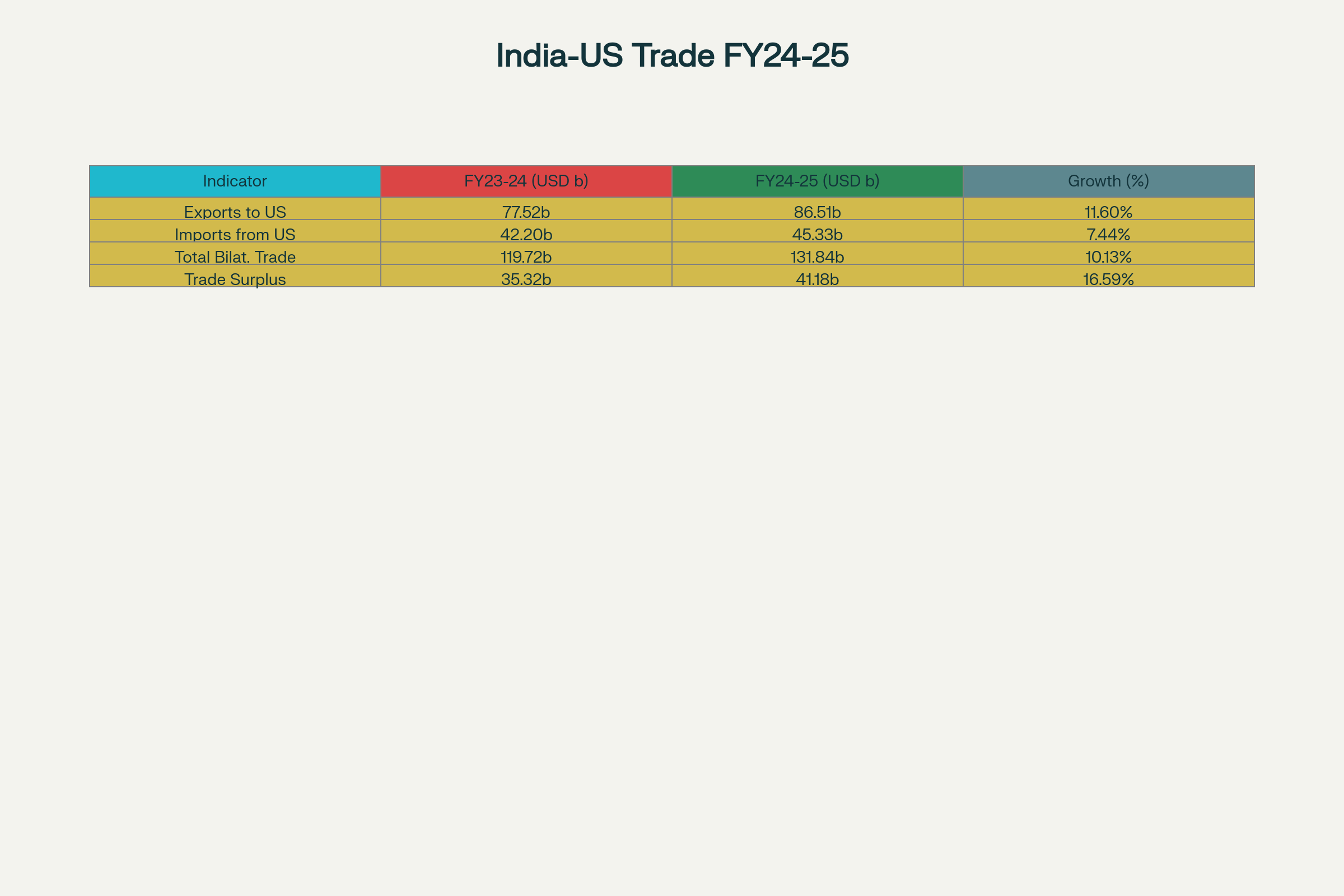Key Highlights
- Trump administration imposed 50% total tariffs on Indian imports, marking the highest trade barriers on any Asian partner
- India’s $86.51 billion exports to the US now face unprecedented threat, with analysts warning of potential GDP growth reduction to 6% from 6.2%
- Strategic energy security versus geopolitical pressure creates complex diplomatic challenge as India maintains position on Russian crude oil imports
Opening Overview
The Trump tariffs on India represent a seismic shift in US-India trade relations, creating the most significant diplomatic and economic challenge between the two nations in decades. Vice President JD Vance’s recent revelation that these punitive measures constitute “aggressive economic leverage” designed to force Russia into ending its Ukraine conflict highlights how Trump tariffs on India have become a cornerstone of broader geopolitical strategy.
The administration’s decision to impose a total 50% duty on Indian imports transforms the dynamics of bilateral trade worth $131.8 billion annually. This escalation, which includes an additional 25% penalty specifically targeting India’s Russian crude oil purchases, positions Trump tariffs on India as among the highest trade barriers imposed by the United States on any major economy. The policy directly challenges India’s energy security framework while testing the resilience of what has traditionally been viewed as a strategic partnership between the world’s oldest and largest democracies.
Economic Impact Assessment: Quantifying the Trade War Consequences
- Trump tariffs on India threaten $87 billion worth of annual exports to the US, equivalent to 2.2% of India’s GDP
- Labor-intensive sectors including textiles, gems, and leather goods face immediate competitiveness challenges against Vietnamese and Bangladeshi alternatives
The economic ramifications of Trump tariffs on India extend far beyond immediate trade statistics, creating ripple effects across multiple sectors of the Indian economy. Analysis by Japanese brokerage Nomura indicates that sustained 50% tariffs could reduce India’s GDP growth by 1 percentage point over time, with the most severe impact concentrated in labor-intensive manufacturing sectors. The Trump tariffs on India particularly threaten small and medium enterprises that form the backbone of India’s export economy.
Industry experts warn that most Indian exporters lack the capacity to absorb even 10-15% tariff increases, making the current 50% levy economically devastating. The Trump tariffs on India effectively create conditions resembling a trade embargo for affected products, forcing a fundamental restructuring of export strategies. Engineering exports alone face potential losses of $4-5 billion annually, while overall economic forecasts have been revised downward from 6.5% to potentially 6% GDP growth.
The currency implications of Trump tariffs on India have already manifested through rupee weakness in offshore markets, raising concerns about imported inflation and increased borrowing costs for companies with foreign debt exposure. Despite initial positive market reactions, sectors like gems and jewelry, automobiles, and textiles experienced significant pressure as investors processed the long-term implications of Trump tariffs on India.
Strategic Energy Security: The Russian Oil Dilemma
- India imports 1.75 million barrels per day from Russia, representing 35-40% of total crude oil consumption during January-June 2025
- Russian oil market share surged from 0.2% before the Ukraine conflict to as high as 40% at peak periods
The core justification for Trump tariffs on India lies in New Delhi’s strategic decision to maintain energy procurement from Russia despite Western sanctions. India’s transformation from minimal Russian oil dependence to making Moscow its largest crude supplier reflects pragmatic energy security calculations that now clash directly with US geopolitical objectives. The Trump tariffs on India specifically target this relationship, viewing energy trade as indirect support for Russia’s military campaign.
External Affairs Minister S. Jaishankar’s response to Trump tariffs on India emphasizes the inconsistency in American criticism, noting that both European nations and the United States itself continue purchasing Russian oil and refined products. This defense of India’s position highlights how Trump tariffs on India create diplomatic tensions over what New Delhi considers legitimate business transactions driven by market dynamics and national interest.
The energy security implications extend beyond immediate cost considerations, as Trump tariffs on India force potential diversification away from Russian suppliers that could increase India’s oil import bill by $9-11 billion annually. The administration’s strategy assumes that Trump tariffs on India will create sufficient economic pressure to override India’s energy security calculations, a premise that Indian officials strongly dispute.
Data from the Centre for Research on Energy and Clean Air reveals that Asia’s richest businessman, Mukesh Ambani’s Reliance Industries, imported 183 million barrels of Russian crude during the first seven months of 2025, reflecting a 64% year-on-year increase valued at $8.7 billion. This scale of energy trade demonstrates the depth of economic relationships that Trump tariffs on India seek to disrupt.

India-US Trade Statistics for FY 2023-24 and FY 2024-25 with Growth Percentages
Diplomatic Response and Future Trajectory
- India maintains its sovereign right to trade with Russia while calling Trump tariffs “unjustified and unreasonable”
- Bilateral negotiations continue with US trade team scheduled for sixth round of talks from August 25
India’s diplomatic response to Trump tariffs on India reflects a careful balance between defending national sovereignty and maintaining strategic partnership with the United States. The Ministry of External Affairs characterizes Trump tariffs on India as fundamentally unfair, emphasizing that India’s energy procurement decisions align with national interest rather than ideological support for Russia. This position sets up a complex negotiation dynamic where Trump tariffs on India serve as both economic pressure and diplomatic leverage.
The timing of Trump tariffs on India coincides with broader US-India trade agreement negotiations, creating additional complexity in bilateral relations. American trade teams scheduled to visit India for the sixth round of talks face the challenge of advancing cooperative frameworks while Trump tariffs on India create immediate economic friction. The administration’s strategy appears designed to use Trump tariffs on India as negotiating leverage rather than permanent policy, though Indian officials express skepticism about this approach.
International observers note that Trump tariffs on India place the United States in the position of demanding trade compliance from a strategic partner while maintaining its own complex economic relationships with sanctioned entities. The policy creates precedent concerns for other nations that might face similar economic pressure tactics, potentially undermining the multilateral trade framework that has traditionally governed international commerce.
The European Union’s parallel restrictions on Russian petroleum products, effective January 2026, create additional pressure on India’s energy sourcing strategy, though Indian officials emphasize the distinction between voluntary diversification and coercive Trump tariffs on India. This convergence of Western pressure tactics suggests that Trump tariffs on India represent part of a coordinated strategy rather than unilateral American policy.
Closing Assessment
The implementation of Trump tariffs on India marks a watershed moment in US-India relations, testing the resilience of a partnership built over decades of growing economic and strategic cooperation. These unprecedented trade barriers demonstrate how economic policy has become weaponized in service of broader geopolitical objectives, with India caught between energy security imperatives and alliance pressure. The Trump tariffs on India ultimately represent a fundamental question about sovereignty in an interconnected global economy.
The August 27 deadline for the additional 25% penalty tariff creates immediate urgency for diplomatic resolution, though both sides appear committed to their respective positions. The success or failure of Trump tariffs on India as a policy tool will likely influence future American approaches to economic coercion, making this dispute a critical test case for 21st-century trade diplomacy. Whether Trump tariffs on India achieve their stated objective of pressuring Russia through secondary sanctions, or instead damage US-India relations while failing to meaningfully impact the Ukraine conflict, remains the defining question for this ambitious but controversial strategy.


